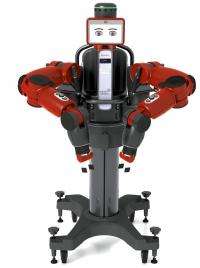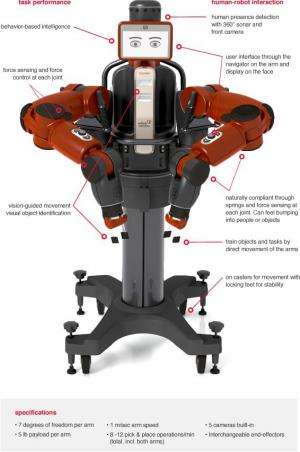September 18, 2012 report
Your next assembly lines may have Baxter robot doing pick-up (w/ Video)

(Phys.org)—Rethink Robotics is introducing Baxter to the manufacturing sector with a note: Baxter can ignite a revolution in breaking down costs and safety barriers holding back automation in American manufacturing. The Boston-based company says the $22,000 (list price) robot is a fraction of the cost of traditional industrial robots "with zero integration required." Baxter has been expressly designed to work on assembly lines to perform menial tasks. Baxter has two arms, each with seven degrees of freedom, and a reach similar to that of a human, to take over the mindless menial tasks. It can load, unload, sort, pack, unpack, snap-fit, grind and polish.
What is not at all mindless about Baxter is its design in that, for an industrial robot, Baxter enjoys an incredible lightness of non-being. Baxter has thick, round arms, but they are not heavy. The arm moves in a fluid motion. "When you hold the cuff, the robot goes into gravity-compensation," said Rodney Brooks, the company founder, "zero-force mode," as if the arm is floating.
The company offers Baxter with two kinds of grippers to choose from. Electric parallel grippers enable Baxter to pick up objects of varying sizes. Vacuum cup grippers are meant for hard-to-grasp objects, such as smooth, nonporous or relatively flat items.
While Baxter is not the ideal choice for tasks that require an extremely strong or fast industrial robot, Baxter is smart enough to adapt to changes. The robot uses vision to locate and grasp objects, and can be programmed to perform a new task just by holding its arms and moving them to the desired position. The robot can continue to work even after missing a pick-up or dropping a part. It can visually detect parts and adapt to variations in part placement and conveyor speed. If Baxter drops an object, it knows to get another before trying to finish the task.

Another differentiator is that, while Baxter is smart, it does not require a high learning curve. One of the argued barriers to industrial adoption of robots has been training requirements to operate industrial robots. The disadvantage has been in the thought of requiring employees to train in programming and in interacting with new robotic equipment, eating up time and financial output. Rethink's team claims Baxter units can be retasked in a matter of minutes. "No custom application code is required to get it started. So no costly software or manufacturing engineers are required to program it," according to the company. Baxter is taught via a graphical user interface and through direct manipulation of its robot arms. Nontechnical, hourly workers can train and retrain Baxter right on the line.
As for safety, the designers gave Baxter sensors to detect people within contact distance and trigger the robot to slow to safe operation speeds. If Baxter's power supply were cut, its arms would relax slowly. Employees would have time to move out of the way.
Baxter is based on the vision of roboticist. Rodney Brooks, company founder of Rethink Robotics, which started in 2008. Baxter's first shipments will start next month.
More information: www.heartlandrobotics.com/inde … php/products/baxter/
© 2012 Phys.org















